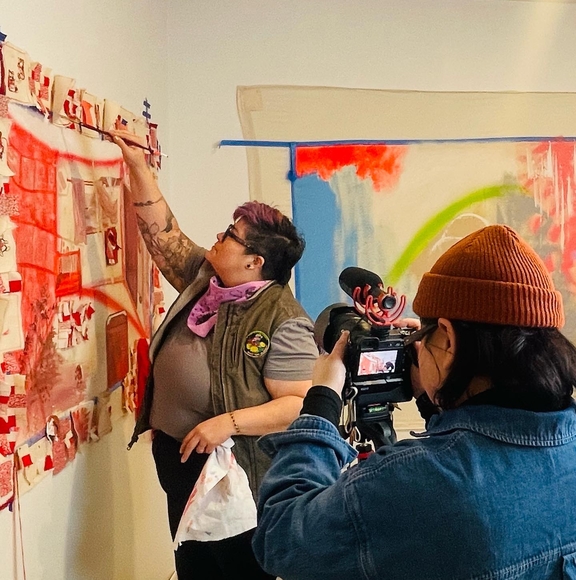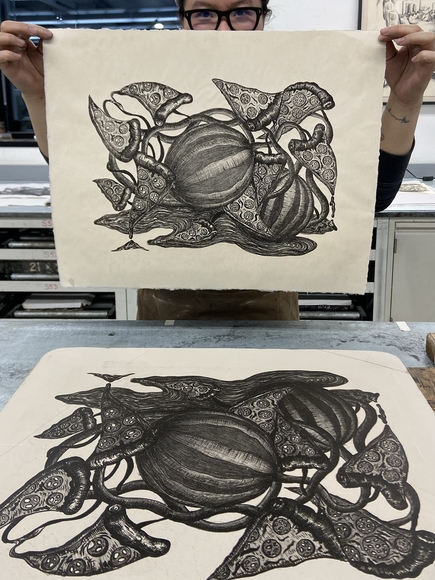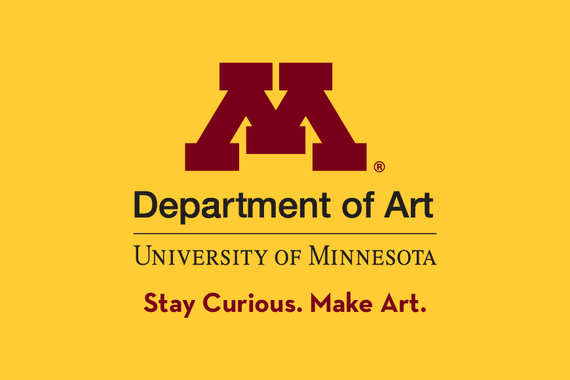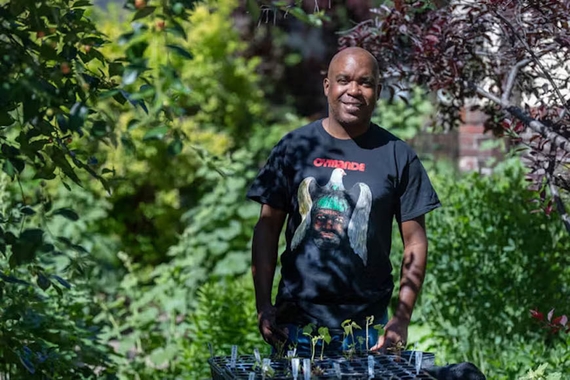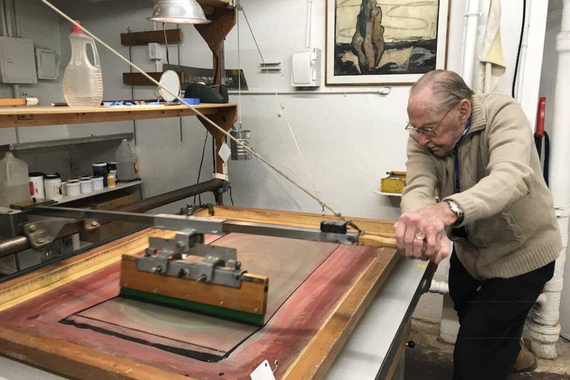Printmaker Turned Filmmaker: A Q&A with artist Mai Tran
Born and raised in Vietnam, Mai Tran moved to Minnesota in 2015 to attend Minnesota State University-Mankato, where she earned an MA and a BFA in Printmaking and Photography, and now is an MFA candidate here in the University of Minnesota Department of Art. The primary focus of her studio practice is creating intricately detailed woodcut prints that explore the connections between American and Vietnamese cultures — traditional Vietnamese foods and mythology are interwoven with American things like cheeseburgers, water towers, and winter scenes. "My woodcut prints hold true to traditional printmaking practices but deliver new narratives, linking one culture to another," the artist explains.
But Mai has added a new medium to her repertoire: filmmaking. Still active in the Mankato art scene, she has teamed up with community art space The 410 Project to develop 410 Studios, producing a series of video interviews profiling prominent local artists, all of which Mai has directed. (One recent episode even features UMN MFA Alum Josh Winkler.)
We were curious about how these two different creative practices overlap and intertwine, and Mai took time out of her busy schedule to fill us in!

Russ White: I know of your work primarily within the realm of printmaking — creating large-scale, incredibly detailed woodcut prints, some as large as four or five feet tall — so I was surprised to see you announce a new undertaking as a director of short documentary films for 410 Studios, an offshoot of the 410 Project artspace in Mankato, Minnesota. Is this your first foray into filmmaking, and how did you get involved with this video series?
Mai Tran: I started learning about video making in early 2020 but only made a few short videos to keep the practice going. My long-term goal is to make high-quality and cinematic printmaking instruction videos at some point in the future. Through art classes, I got introduced to several amazing artist documentaries from channels such as Art 21, Louisiana Channel, etc. Those videos are good but usually long, and I sometimes find it hard for students to pay attention. So I want to make a short, informative, and inspirational series to highlight and tell artists’ stories, focusing only on Minnesota creatives. Working with Dana Sikkila and her gallery space in Mankato for the past couple of years, I’ve noticed that so many talented artists in our community do not have opportunities to speak about the minds and the process behind their works. I proposed this idea to Dana, and here we are.
RW: The videos you have directed so far focus on individual artists in so-called “greater Minnesota” — one from Mankato, showing at the 410 Project; another from Delavan, south of Mankato; and another from Erhard, between Fergus Falls and Fargo. What role do you find place plays in these artists’ studio practices and your own, moving as you do now between Mankato and the Twin Cities while making work connected to Vietnamese culture?
MT: Place is important. I moved a lot growing up. I also like to travel to different places, and each place has its unique value and story to tell. Those things will be reflected in the artist’s work in some ways. I’m curious and always intrigued by learning new things wherever I go. And that’s how I narrate stories in my works as well.
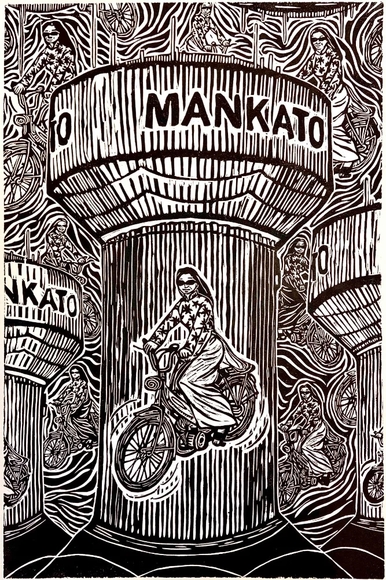
RW: For those who’ve never been to Mankato (only a 1.5 hr drive south of the Twin Cities), can you describe what the city is like and what kind of community you’ve found around the 410 Project?
MT: Mankato is a small city in south-central Minnesota with many small communities surrounding it. The community has grown so much since I came to Mankato 8 years ago. There are so many creatives living and making in and around the area. Visual artists, musicians, writers, theatre, dance, you can truly see it all in Mankato, not just view it but be a part of it as well. There’s a lot of support for creatives and opportunities to collaborate between disciplines. It’s continually growing, and new ideas are constantly being shared. I hope to connect artists from the city to Mankato and vice versa, building opportunities for everyone.
RW: Are there any technical or storytelling aspects of filmmaking that overlap with printmaking, or does it scratch a different itch entirely?
MT: I’m always trying to challenge myself, inside and outside printmaking. With my printmaking, I’m sharing my stories of how my Vietnamese culture blends with the American world around me—using symbolism and mark-making to tell these stories. Filmmaking is very similar, but instead of sharing my story, it’s sharing others’. But instead of just seeing the final product, we get to know the process that gets the artist there. We don’t see that when we look at the work in person or on a gallery wall. Filmmaking allows us to connect more, not just to the work but to the artist as well.
RW: I know from my own experience how rewarding it can be to interview and highlight the work that other artists are doing — you learn something that can be applied to your own practice almost every time. I imagine the same is true of teaching, as well.
What is your vision for 410 Studios and this video series going forward, and do you anticipate it impacting or overlapping with your printmaking practice in any way?
MT: My goals for 410 Studios are to learn about other creatives through the filmmaking process and allow artists throughout the state to connect. I want to see what someone else is doing on the other side of the state. 410 Studios will also give me more insight into how I look at my work and think of different ways to express my ideas. Learning the tools of filmmaking will, down the line, let me create printmaking content to help teach the next generation of printmakers.
To see more of Mai Tran's work, visit maitranarts.com or follow her on Instagram @mmai.tran. She was also recently the subject of her own video profile courtesy of PBS Postcards.
To see all of the videos produced by 410 Studios, find them on YouTube.
